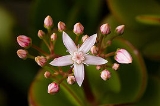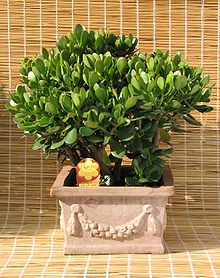
Jade plant
Encyclopedia
Commonly known as jade plant, friendship tree, lucky plant or Money Plant, Crassula ovata is a succulent plant
with small pink or white flowers. It is native to South Africa
, and is common as a houseplant worldwide. It is sometimes referred to as the money tree; however, the tree Pachira aquatica
is also so called.
Jades are evergreen plants with thick branches and smooth, rounded, fleshy leaves that grow in opposing pairs along the branches. Leaves are a rich jade green; some varieties may develop a red tinge on the edges of leaves when exposed to high levels of sunlight. New stem growth is the same color and texture as the leaves, but becomes brown and woody with age. Under the right conditions, they may produce small white or pink star-like flowers in early spring.
The jade plant lends itself easily to the bonsai
form and is popular as an indoor bonsai
.
They will grow in full sun to light shade. However, they do not tolerate extreme heat or overexposure to direct sun very well, showing damage ranging from scorched leaves to loss of foliage and rotting stems. Most of the common species will tolerate a limited degree of frost but overexposure to cold weather will kill them.

 The jade plant benefits from pruning, which should be done in the spring, before the growing season. Pruning a jade can be done over a period of a few weeks, and involves cutting stems back to a lateral branch. The purpose of pruning is twofold: for a top-heavy succulent like the jade, it is important that its trunk be able to support the weight of its leaves and pruning encourages the trunk to grow in size; pruning also encourages root growth. Calluses should form on new cuts after a few days and new growth should emerge from the stump within a few weeks of the cut.
The jade plant benefits from pruning, which should be done in the spring, before the growing season. Pruning a jade can be done over a period of a few weeks, and involves cutting stems back to a lateral branch. The purpose of pruning is twofold: for a top-heavy succulent like the jade, it is important that its trunk be able to support the weight of its leaves and pruning encourages the trunk to grow in size; pruning also encourages root growth. Calluses should form on new cuts after a few days and new growth should emerge from the stump within a few weeks of the cut.
s are common pests to jades and can cause deformation to new growth. An infestation can be eliminated by killing each bug with a small cottonswab or paintbrush that has been dipped in rubbing alcohol. This process is repeated every day until all of the mealybugs have been killed, as new bugs may still be hatching even after the live bugs on the plant have been killed.
Aphid
s are also common pests, though they tend to infest only the flower stalks. Red spider mites can also cause problems.
The use of pesticides is avoided with Jades, as they are very sensitive to them.
, haydite, turface, or small gravel and grit. Others have used coir
, pine bark and river stones. The general consensus among growers is that the soil should drain quickly and be allowed to dry between waterings, so having a good amount of grit and gravel in the mix is essential.
In cultivation, new plants are made by cutting new growth (stems or leaves) and letting them dry. Roots will develop in or out of soil, though inserting the stem into moist soil will increase rooting speed.
Succulent plant
Succulent plants, also known as succulents or fat plants, are water-retaining plants adapted to arid climates or soil conditions. Succulent plants store water in their leaves, stems, and also in roots...
with small pink or white flowers. It is native to South Africa
South Africa
The Republic of South Africa is a country in southern Africa. Located at the southern tip of Africa, it is divided into nine provinces, with of coastline on the Atlantic and Indian oceans...
, and is common as a houseplant worldwide. It is sometimes referred to as the money tree; however, the tree Pachira aquatica
Pachira aquatica
Pachira aquatica is a tropical wetland tree of the genus Pachira, native to Central and South America where it grows in swamps. It is known by the common names Malabar chestnut, Guiana chestnut, provision tree, saba nut, Monguba , Pumpo and is commercially sold under the name money tree and money...
is also so called.
Jades are evergreen plants with thick branches and smooth, rounded, fleshy leaves that grow in opposing pairs along the branches. Leaves are a rich jade green; some varieties may develop a red tinge on the edges of leaves when exposed to high levels of sunlight. New stem growth is the same color and texture as the leaves, but becomes brown and woody with age. Under the right conditions, they may produce small white or pink star-like flowers in early spring.
The jade plant lends itself easily to the bonsai
Bonsai
is a Japanese art form using miniature trees grown in containers. Similar practices exist in other cultures, including the Chinese tradition of penjing from which the art originated, and the miniature living landscapes of Vietnamese hòn non bộ...
form and is popular as an indoor bonsai
Indoor bonsai
Indoor bonsai are bonsai which are cultivated for the indoor environment. Traditionally, bonsai are temperate climate trees grown outdoors in containers. Kept in the artificial environment of a home, these trees weaken and die. But a number of tropical and sub-tropical tree species will survive and...
.
Care
As succulents, they require a normal watering when the soil is dry in the summer, and very little watering in the winter. Overwatering will cause them to lose their leaves (it is easy to identify overwatering by the characteristic crinkling look that the fallen leaves have) and eventually the stem will rot away. Though jades can survive overwatering, it is best to keep them on a 10 - 20 day cycle in the summer, and even less (up to a month dry) in the winter. Letting the soil dry between waterings is essential for a healthy jade.They will grow in full sun to light shade. However, they do not tolerate extreme heat or overexposure to direct sun very well, showing damage ranging from scorched leaves to loss of foliage and rotting stems. Most of the common species will tolerate a limited degree of frost but overexposure to cold weather will kill them.


Pests
MealybugMealybug
Mealybugs are insects in the family Pseudococcidae, unarmored scale insects found in moist, warm climates. They are considered pests as they feed on plant juices of greenhouse plants, house plants and subtropical trees and also acts as a vector for several plant diseases.-Distribution:Mealybugs...
s are common pests to jades and can cause deformation to new growth. An infestation can be eliminated by killing each bug with a small cottonswab or paintbrush that has been dipped in rubbing alcohol. This process is repeated every day until all of the mealybugs have been killed, as new bugs may still be hatching even after the live bugs on the plant have been killed.
Aphid
Aphid
Aphids, also known as plant lice and in Britain and the Commonwealth as greenflies, blackflies or whiteflies, are small sap sucking insects, and members of the superfamily Aphidoidea. Aphids are among the most destructive insect pests on cultivated plants in temperate regions...
s are also common pests, though they tend to infest only the flower stalks. Red spider mites can also cause problems.
The use of pesticides is avoided with Jades, as they are very sensitive to them.
Soil
Jades grow best in well drained soil that does not have peat moss or other particles that will retain large amounts of water. Jade trees enjoy rocky hillsides and arid soil, so in cultivation many different soil mixes are used to mimic these favorable natural conditions. Some growers recommend 50/50 soil mixes of organic topsoil to perlitePerlite
Perlite is an amorphous volcanic glass that has a relatively high water content, typically formed by the hydration of obsidian. It occurs naturally and has the unusual property of greatly expanding when heated sufficiently...
, haydite, turface, or small gravel and grit. Others have used coir
Coir
Coir is a natural fibre extracted from the husk of coconut and used in products such as floor mats, doormats, brushes, mattresses etc. Technically coir is the fibrous material found between the hard, internal shell and the outer coat of a coconut. Other uses of brown coir are in upholstery...
, pine bark and river stones. The general consensus among growers is that the soil should drain quickly and be allowed to dry between waterings, so having a good amount of grit and gravel in the mix is essential.
Flowering
To encourage bloom, allow the plant to go without water around the time of the first frost. When the days get short, withhold the water completely and let the plant withstand the cool nights. Several weeks of this dry, cold treatment followed by regular watering will result in blossoms around the shortest day of the year. Regular watering, or nights too warm, and the plant will remain healthy, but bloom-less.Propagation
Jade trees are notoriously easy to propagate. They can be propagated by stem or leaf cuttings. In the wild, stems and leaves will often break off and fall to the ground, and after a few weeks, they may grow roots and form a new plant. Or, they can be cut and placed in a water container until roots are grown (approx 2 weeks) then planted in soil.In cultivation, new plants are made by cutting new growth (stems or leaves) and letting them dry. Roots will develop in or out of soil, though inserting the stem into moist soil will increase rooting speed.

